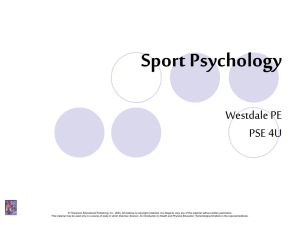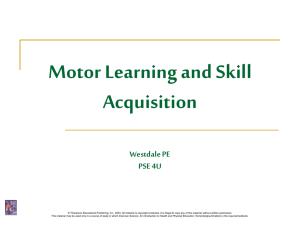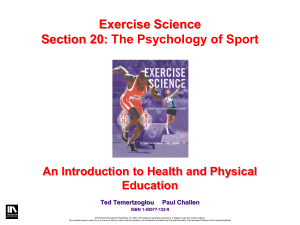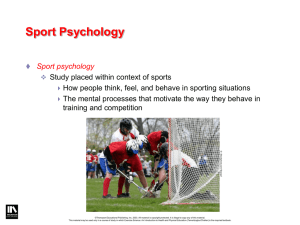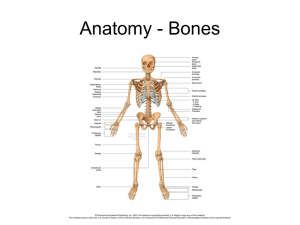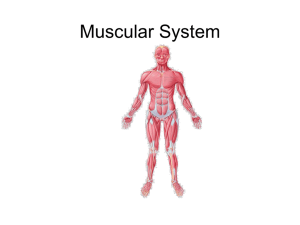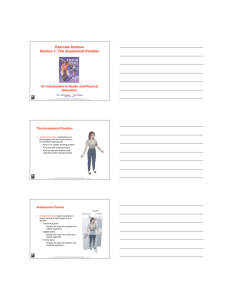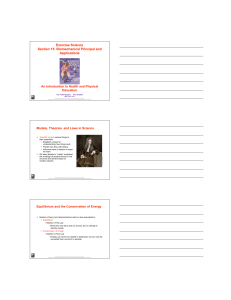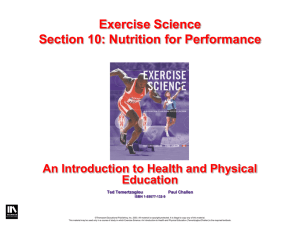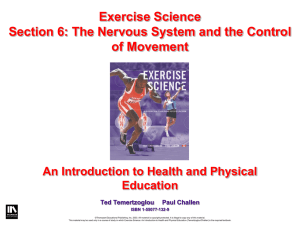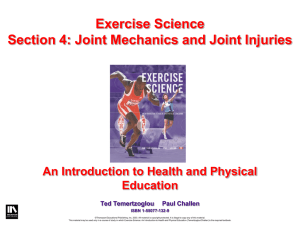Biomechanics
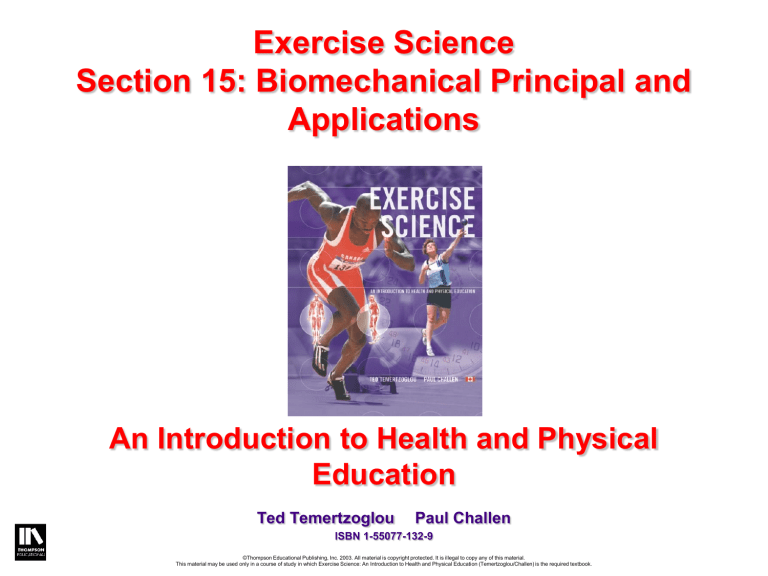
Exercise Science
Section 15: Biomechanical Principal and
Applications
An Introduction to Health and Physical
Education
Ted Temertzoglou Paul Challen
ISBN 1-55077-132-9
©Thompson Educational Publishing, Inc. 2003. All material is copyright protected. It is illegal to copy any of this material.
This material may be used only in a course of study in which Exercise Science: An Introduction to Health and Physical Education (Temertzoglou/Challen) is the required textbook.
Models, Theories, and Laws in Science
Scientific models reduce things to their essentials
Establish a basis for understanding how things work
Predict how they will behave
Influence them to behave in ways we want
Sir Isaac Newton’s “model” explained the workings of physical forces in the universe and laid the basis for modern physics
©Thompson Educational Publishing, Inc. 2003. All material is copyright protected. It is illegal to copy any of this material.
This material may be used only in a course of study in which Exercise Science: An Introduction to Health and Physical Education (Temertzoglou/Challen) is the required textbook.
Equilibrium and the Conservation of Energy
Newton’s theory (and biomechanics) rests on two assumptions:
Equilibrium
Newton’s First Law
More than one force acts on a body, but no change in velocity results
Conservation of energy
Newton’s Third Law
Energy can never be created or destroyed, but can only be converted from one form to another
©Thompson Educational Publishing, Inc. 2003. All material is copyright protected. It is illegal to copy any of this material.
This material may be used only in a course of study in which Exercise Science: An Introduction to Health and Physical Education (Temertzoglou/Challen) is the required textbook.
Isaac Newton’s “Model Universe”
Three Laws of Motion
The Law of Inertia
Every object in a state of uniform motion tends to remain in that state of motion unless an external force is applied to it
The Law of Acceleration
A force applied to a body causes an acceleration of that body of a magnitude proportional to the force, in the direction of the force, and inversely proportional to the body’s mass
The Law of Reaction
For every action there is an equal and opposite reaction
©Thompson Educational Publishing, Inc. 2003. All material is copyright protected. It is illegal to copy any of this material.
This material may be used only in a course of study in which Exercise Science: An Introduction to Health and Physical Education (Temertzoglou/Challen) is the required textbook.
Types of Motion
Linear (or translational) motion
Movement in a particular direction
Force generated by the athlete’s muscles and the resulting motion is in a straight line
Rotational motion
Movement about an axis
Force does not act through the centre of mass, but rather is “offcentre,” and this results in rotation
Rotational motion
©Thompson Educational Publishing, Inc. 2003. All material is copyright protected. It is illegal to copy any of this material.
This material may be used only in a course of study in which Exercise Science: An Introduction to Health and Physical Education (Temertzoglou/Challen) is the required textbook.
Lever Systems
Every moveable bone in the human body is part of a lever system that facilitates movement
Three classes of levers
Class I lever (e.g. teeter-totter)
Class II lever (e.g. wheelbarrow)
Class III lever (e.g. snow shovelling)
©Thompson Educational Publishing, Inc. 2003. All material is copyright protected. It is illegal to copy any of this material.
This material may be used only in a course of study in which Exercise Science: An Introduction to Health and Physical Education (Temertzoglou/Challen) is the required textbook.
Lever Systems
Class I lever (e.g. teeter-totter)
The fulcrum (axis) is located between the force (effort) and the resistance load
©Thompson Educational Publishing, Inc. 2003. All material is copyright protected. It is illegal to copy any of this material.
This material may be used only in a course of study in which Exercise Science: An Introduction to Health and Physical Education (Temertzoglou/Challen) is the required textbook.
Lever Systems
Class II lever (e.g. wheelbarrow)
The resistance is between the force and the fulcrum
©Thompson Educational Publishing, Inc. 2003. All material is copyright protected. It is illegal to copy any of this material.
This material may be used only in a course of study in which Exercise Science: An Introduction to Health and Physical Education (Temertzoglou/Challen) is the required textbook.
Lever Systems
Class III lever (e.g. shovelling)
The force is between the fulcrum and the resistance
©Thompson Educational Publishing, Inc. 2003. All material is copyright protected. It is illegal to copy any of this material.
This material may be used only in a course of study in which Exercise Science: An Introduction to Health and Physical Education (Temertzoglou/Challen) is the required textbook.
Seven Principles of Biomechanics
The seven principles of biomechanics
Allows you to gain insight into movement dynamics
The Coaching Association of Canada’s National Coaching
Certification Program (NCCP) Level 2 Theory course sets forward these seven principles grouped into four broad categories:
Stability
Maximum effort
Linear motion
Angular motion
©Thompson Educational Publishing, Inc. 2003. All material is copyright protected. It is illegal to copy any of this material.
This material may be used only in a course of study in which Exercise Science: An Introduction to Health and Physical Education (Temertzoglou/Challen) is the required textbook.
Stability
Principle 1:
The lower the centre of mass, the larger the base of support, the closer the centre of mass to the base of support, and the greater the mass, the more stability increases
Principle 1 has four subcomponents:
The height of the centre of mass
The line of gravity
The base of support
Mass
©Thompson Educational Publishing, Inc. 2003. All material is copyright protected. It is illegal to copy any of this material.
This material may be used only in a course of study in which Exercise Science: An Introduction to Health and Physical Education (Temertzoglou/Challen) is the required textbook.
Maximum Effort
Principle 2:
The production of maximum force requires the use of all possible joint movements that contribute to the task’s objective
©Thompson Educational Publishing, Inc. 2003. All material is copyright protected. It is illegal to copy any of this material.
This material may be used only in a course of study in which Exercise Science: An Introduction to Health and Physical Education (Temertzoglou/Challen) is the required textbook.
Maximum Velocity
Principle 3:
The production of maximum velocity requires the use of joints in order – from largest to smallest
©Thompson Educational Publishing, Inc. 2003. All material is copyright protected. It is illegal to copy any of this material.
This material may be used only in a course of study in which Exercise Science: An Introduction to Health and Physical Education (Temertzoglou/Challen) is the required textbook.
Linear Motion
Principle 4:
The greater the applied impulse, the greater the increase in velocity
©Thompson Educational Publishing, Inc. 2003. All material is copyright protected. It is illegal to copy any of this material.
This material may be used only in a course of study in which Exercise Science: An Introduction to Health and Physical Education (Temertzoglou/Challen) is the required textbook.
Linear Motion
Principle 5:
Movement usually occurs in the direction opposite that of the applied force
©Thompson Educational Publishing, Inc. 2003. All material is copyright protected. It is illegal to copy any of this material.
This material may be used only in a course of study in which Exercise Science: An Introduction to Health and Physical Education (Temertzoglou/Challen) is the required textbook.
Angular Motion
Principle 6:
Angular motion is produced by the application of a force acting at some distance from an axis, that is, by torque
©Thompson Educational Publishing, Inc. 2003. All material is copyright protected. It is illegal to copy any of this material.
This material may be used only in a course of study in which Exercise Science: An Introduction to Health and Physical Education (Temertzoglou/Challen) is the required textbook.
Angular Motion
Principle 7:
Angular momentum is constant when an athlete or object is free in the air
©Thompson Educational Publishing, Inc. 2003. All material is copyright protected. It is illegal to copy any of this material.
This material may be used only in a course of study in which Exercise Science: An Introduction to Health and Physical Education (Temertzoglou/Challen) is the required textbook.
Applications in Biomechanics
Performance improvement
Coaches and athletes focused on “performance improvement” within the aspects of technique and sport training
Injury prevention and rehabilitation
High level of interest in biomechanics from sports medicine specialists, trainers, and injured athletes in relation to “injury prevention and rehabilitation”
Fitness and personal training
Biomechanical analysis can be applied both to exercise and to equipment
©Thompson Educational Publishing, Inc. 2003. All material is copyright protected. It is illegal to copy any of this material.
This material may be used only in a course of study in which Exercise Science: An Introduction to Health and Physical Education (Temertzoglou/Challen) is the required textbook.
Injury Prevention and Rehabilitation
Progressive resistance training to improve muscular endurance, size, and tensile strength of both muscle and connective tissue can be integrated into the off- and pre-season schedule
Specific design of aerobic and muscular warm-up tailored to the activities planned for the workout will bring more injury prevention value to the session
All key muscles to be used must be stretched
Muscle imbalance needs to be addressed
©Thompson Educational Publishing, Inc. 2003. All material is copyright protected. It is illegal to copy any of this material.
This material may be used only in a course of study in which Exercise Science: An Introduction to Health and Physical Education (Temertzoglou/Challen) is the required textbook.
Fitness and Personal Training
Biomechanical analysis begins by examining the method of execution of an exercise; such analyses enable one to give advice concerning:
The position of joints to isolate specific muscles
How to align the movement to the muscle
How to combine muscles for optimal results
The optimal speed for the objective
The best starting position and range of motion for an exercise
How to modify the leverage to gain a greater strength output
©Thompson Educational Publishing, Inc. 2003. All material is copyright protected. It is illegal to copy any of this material.
This material may be used only in a course of study in which Exercise Science: An Introduction to Health and Physical Education (Temertzoglou/Challen) is the required textbook.
©Thompson Educational Publishing, Inc. 2003. All material is copyright protected. It is illegal to copy any of this material.
This material may be used only in a course of study in which Exercise Science: An Introduction to Health and Physical Education (Temertzoglou/Challen) is the required textbook.
